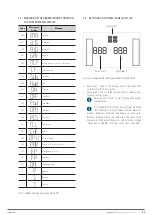
16
SALICRU
For longer lengths correct the cross sections to avoid
voltage drops, respecting the regulations or standards
corresponding to the country.
In the same documentation and for each configuration,
information for ‘N’ units in parallel, as well as backfeed
protection characteristics, is available.
•
In parallel systems, the length and cross section of
the cables that run from the distribution or manual
bypass board to each UPS and from these to the board will
be the same for all of them without exception.
•
The cross section of the cables must always be considered
in relation to the size of the terminals of the switches, so
that they are correctly fastened across their entire cross
section for optimum contact between the two elements.
•
Only rated currents are printed on the nameplate of the de-
vice as indicated by the EN-IEC 62040-1 safety standard.
For the calculation of the input current, the power factor
and the device’s own performance have been considered.
Overload conditions are considered a non-permanent and
exceptional working mode, and will not be taken into ac-
count in the application of the protections. Do not connect
appliances or devices which may overload the UPS to the
terminals and/or outlets, such as motors.
•
If peripheral input, output or bypass elements such as trans-
formers or autotransformers are added to the UPS or parallel
system, the currents indicated on the nameplates of these
elements must be taken into consideration in order to use
the appropriate cross sections, in compliance with local and/
or national low voltage electrotechnical regulations.
•
When a galvanic isolation transformer is added to a UPS or
parallel system as an optional extra, as standard or inde-
pendently, either on the input line, at the output or both, it
must be fitted with protection against indirect contact (dif-
ferential circuit breaker) at the output of each transformer,
since, due to its own insulation properties, it will prevent
the tripping of the protections placed on the primary of the
isolation transformer in case of electric shock on the sec-
ondary (output of the isolation transformer).
•
We remind you that all the isolation transformers installed
or factory supplied, have the output neutral earthed through
a jumper between the neutral terminal and earth. If the
isolated output neutral is required, this jumper must be re-
moved, taking the precautions indicated in the respective
local and/or national low voltage regulations.
•
This device is suitable for installation in networks
with TT, TN-S, TN-C or IT power distribution sys-
tems, taking into account at the time of installation the
particularities of the system used and the national elec-
trical regulations of the destination country.
•
The TWIN PRO2 T features terminals for the installation of
an external emergency power off button
(EPO)
or, failing
that, a single device must be installed to cut the power
supply to the loads in any operating mode.
5.1.5.5. Preliminary considerations before connection,
regarding the batteries and their protections.
•
All standard UPSs incorporate the batteries in the same en-
closure as the device, except the B1s. In the first, battery
protection is by means of internal fuses and is not acces-
sible to the user.
•
Accumulator enclosures or modules also have battery
protections and in this case in duplicate. A number of
internal ones with fuses not accessible to the user and
others with two-pole circuit breaker or fuses.
IM-
PORTANT FOR SAFETY: If batteries are installed
independently, the accumulator bank must be fitted with a
two-pole circuit breaker or disconnect fuses of the size in-
dicated in Tab. 3.
•
Inside the battery module, there are HAZARDOUS VOLT-
AGES with risk of electric shock, so it is classified as a RE-
STRICTED ACCESS AREA.
•
Do not handle the fuse holder or battery circuit
breaker when the device is running. These mecha-
nisms
are not load disconnect type
.
•
If the mains power of the device or parallel system
is cut for longer than a simple intervention and it is
expected that it will be out of service for a prolonged period
time, the system must be shut down completely.
•
The battery circuit is not isolated from the input
voltage. Dangerous voltages can occur between the
terminals of the battery bank and the earth. Check that there
is no input voltage before intervening on the terminals.
5.1.5.6. Connection elements.
•
All of the device’s electrical connections are made from the
back of each unit:
Connection of input and output terminals. Remove the
fixing screws of the protective cover and the cover it-
self to access the terminals.
Connection of the UPS to the battery modules using a
connector.
–
Device and battery module with connector. Remove
the screws and ‘BATTERY CONNECTOR’ cover.
These covers will not be fitted again, put them
away.
–
Device with battery terminals. Arranged next to the
AC power terminals.
–
Battery module with terminals. Remove the screws
and the connections protective cover.
Immediate communication connectors:
–
DB9 for RS-232.
–
USB for communication as peripheral.
–
For connection to external EPO button.
Control connections for parallel systems, DB15 and an-
alogue current signal connectors. Remove the screws
and protective cover to access the last ones.
Slot for the integration of one of the optional electronic
communication units. Remove the fixing screws and
plastic cover to enable it to be inserted.
•
After making the connections, replace all covers
and fixing screws before proceeding with startup
operations to prevent possible accidents caused by direct
contact.
















































